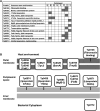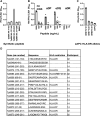Treponema pallidum Periplasmic and Membrane Proteins Are Recognized by Circulating and Skin CD4+ T Cells
- PMID: 38932740
- PMCID: PMC11326851
- DOI: 10.1093/infdis/jiae245
Treponema pallidum Periplasmic and Membrane Proteins Are Recognized by Circulating and Skin CD4+ T Cells
Abstract
Background: Histologic and serologic studies suggest the induction of local and systemic Treponema pallidum-specific CD4+ T-cell responses to T. pallidum infection. We hypothesized that T. pallidum-specific CD4+ T cells are detectable in blood and in the skin rash of secondary syphilis and persist in both compartments after treatment.
Methods: Peripheral blood mononuclear cells collected from 67 participants were screened by interferon-γ (IFN-γ) ELISPOT response to T. pallidum sonicate. T. pallidum-reactive T-cell lines from blood and skin were probed for responses to 89 recombinant T. pallidum antigens. Peptide epitopes and HLA class II restriction were defined for selected antigens.
Results: We detected CD4+ T-cell responses to T. pallidum sonicate ex vivo. Using T. pallidum-reactive T-cell lines we observed recognition of 14 discrete proteins, 13 of which localize to bacterial membranes or the periplasmic space. After therapy, T. pallidum-specific T cells persisted for at least 6 months in skin and 10 years in blood.
Conclusions: T. pallidum infection elicits an antigen-specific CD4+ T-cell response in blood and skin. T. pallidum-specific CD4+ T cells persist as memory in both compartments long after curative therapy. The T. pallidum antigenic targets we identified may be high-priority vaccine candidates.
Keywords: CD4+ T cell; interferon-γ; secondary syphilis; syphilis; tissue-resident memory T cell; vaccine.
© The Author(s) 2024. Published by Oxford University Press on behalf of Infectious Diseases Society of America. All rights reserved. For commercial re-use, please contact reprints@oup.com for reprints and translation rights for reprints. All other permissions can be obtained through our RightsLink service via the Permissions link on the article page on our site—for further information please contact journals.permissions@oup.com.
Conflict of interest statement
Potential conflicts of interest . D. M. K. reports membership on the Scientific Advisory Board of MaxHealth, LLC and Curevo Vaccines; grant support from Sanofi Pasteur; and coinventorship of institutionally owned patents concerning HSV vaccines. All other authors report no potential conflicts. All authors have submitted the ICMJE Form for Disclosure of Potential Conflicts of Interest. Conflicts that the editors consider relevant to the content of the manuscript have been disclosed. Presented in part: “Treponema pallidum specific CD4+ T cell epitope discovery.” AAI Immunology 2022, Portland, OR, May 2022. “Treponema pallidum-specific human CD4v T cell antigens and epitopes.” Gordon Research Symposium on the Biology of Spirochetes, Ventura, CA, June 2022. “Discovery of T. pallidum specific human CD4v T cell antigens and epitopes.” NIH STI CRC Annual National Meeting, virtual, July 2022. “Treponema pallidum-specific memory T cells persist in skin after secondary syphilis.” STI and HIV World Congress, Chicago, IL, July 2023. “Treponema pallidum periplasmic and membrane proteins are recognized by circulating and skin CD4+ T cells.” Gordon Research Conference on the Biology of Spirochetes, Ventura, CA, January 2024.
Figures




Update of
-
Treponema pallidum periplasmic and membrane proteins are recognized by circulating and skin CD4+ T cells.bioRxiv [Preprint]. 2024 Feb 29:2024.02.27.581790. doi: 10.1101/2024.02.27.581790. bioRxiv. 2024. Update in: J Infect Dis. 2024 Aug 16;230(2):281-292. doi: 10.1093/infdis/jiae245. PMID: 38464313 Free PMC article. Updated. Preprint.
Comment in
-
T-Cell Responses to Treponema pallidum Proteins in Blood and Skin to Advance Syphilis Vaccine Design: Learning From Nature.J Infect Dis. 2024 Aug 16;230(2):275-277. doi: 10.1093/infdis/jiae246. J Infect Dis. 2024. PMID: 39147388 Free PMC article. No abstract available.
References
-
- World Health Organization . Sexually transmitted infections (STIs), 2023. https://www.who.int/news-room/fact-sheets/detail/sexually-transmitted-in.... Accessed 18 October 2023.
-
- Centers for Disease Control and Prevention . Sexually Transmitted Disease Surveillance, 2021. https://www.cdc.gov/std/statistics/2022/2021-STD-Surveillance-Report-PDF.... Accessed 12 October 2023.
-
- Baker-Zander SA, Lukehart SA. Macrophage-mediated killing of opsonized Treponema pallidum. J Infect Dis 1992; 165:69–74. - PubMed
MeSH terms
Substances
Supplementary concepts
Grants and funding
LinkOut - more resources
Full Text Sources
Medical
Research Materials

